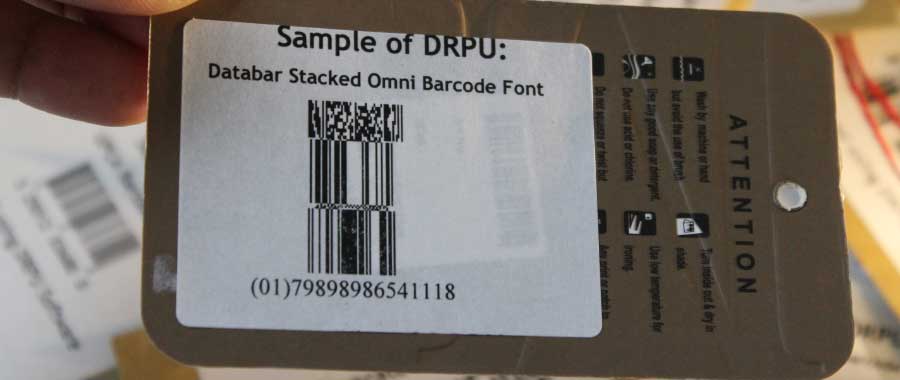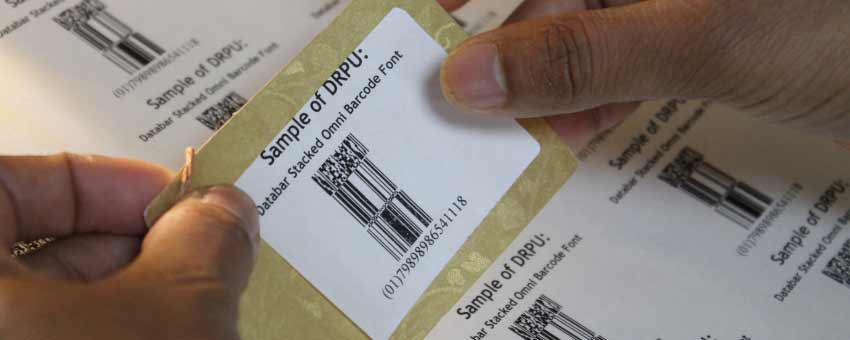Databar Stacked Omni Barcode: Applications, Advantages, and Limitations
| Published Date: 30/05/2023
Databar Stacked Omni barcode has a range of applications across various industries due to its ability to encode multiple pieces of information in a single barcode. Here are some of the most common applications of Databar Stacked Omni barcode:

-
Retail
One of the primary applications of Databar Stacked Omni barcode is in the retail industry. Retailers use Databar Stacked Omni barcodes to encode information such as the GTIN, serial number, expiration date, weight, and dimensions of a product. This information can be used to manage inventory levels, track sales, and ensure that products are sold before they expire. In addition, Databar Stacked Omni barcodes can be used to track product returns and exchanges, making it easier for retailers to manage their returns process.
-
Healthcare
Databar Stacked Omni barcode is also used in the healthcare industry to track medical products, such as medications. The barcode can be used to encode information such as the product name, dosage, and expiration date, which can be used to ensure that medications are not expired before being administered. In addition, Databar Stacked Omni barcode can be used to track medical devices, such as implants and equipment, throughout their lifecycle, enabling healthcare providers to manage inventory levels and track usage.
-
Manufacturing
Manufacturers use Databar Stacked Omni barcode to track inventory levels, manage production processes, and ensure quality control. The barcode can be used to encode information such as the product name, batch number, and expiration date, which can be used to track the movement of products throughout the production process. In addition, Databar Stacked Omni barcode can be used to ensure that products are manufactured to the correct specifications and are not expired before being shipped to customers.
-
Logistics and Transportation
Databar Stacked Omni barcode is also used in the logistics and transportation industry to track shipments and manage inventory levels. The barcode can be used to encode information such as the product name, batch number, and destination, which can be used to track the movement of products throughout the supply chain. In addition, Databar Stacked Omni barcode can be used to manage inventory levels at distribution centers and warehouses, ensuring that products are available when needed.
-
Food and Beverage
Food and beverage manufacturers and retailers use Databar Stacked Omni barcode to track inventory levels, manage expiration dates, and ensure food safety. The barcode can be used to encode information such as the product name, batch number, and expiration date, which can be used to ensure that food products are not expired before being sold.
-
Government and Public Sector
In the government and public sector, Databar Stacked Omni barcode is used to encode a range of information, including passport information, driver's license information, and voting information. This enables government agencies to track and manage information more efficiently and accurately without any errors.
-
Document Management
In document management, Databar Stacked Omni barcode is used to encode document information, such as document type, author, and date of creation. This enables organizations to manage documents more efficiently and accurately, ensuring that they are stored in the correct location and can be retrieved quickly and easily when needed.
In summary, Databar Stacked Omni barcode has a wide range of applications across various industries. It is used to encode product information, patient information, shipment information, and other relevant data, enabling businesses and organizations to manage information more efficiently and accurately.
Limitations of lDatabar Stacked Omni Barcode
While Databar Stacked Omni barcode offers many advantages, there are also some limitations and challenges associated with its use. Here are some of the main limitations of using a Databar Stacked Omni barcode:
-
Limited Scanning Distance:
One of the main limitations of Databar Stacked Omni barcode is its limited scanning distance. This is because the barcode is relatively small and contains a large amount of data, which can make it difficult for barcode scanners to read at a distance. This can be a problem in applications where scanning distance is critical, such as in retail environments or warehouse management systems.
-
Cost of Implementation:
Implementing Databar Stacked Omni barcode can be expensive, as it requires specialized equipment and software.
-
Limited Compatibility:
While Databar Stacked Omni barcode complies with industry standards such as GS1, it may not be compatible with all barcode scanners or software systems. This can be a problem in applications where interoperability is critical, such as in supply chain management or healthcare.
-
Data Entry Errors:
Like all barcodes, Databar Stacked Omni barcode can be subject to data entry errors, such as incorrect product or patient information. This can result in incorrect data being recorded or processed, which can have negative consequences for businesses or organizations.
-
Damage and Obstruction:
Databar Stacked Omni barcode can be subject to damage or obstruction, which can make it difficult or impossible to scan. This can be a problem in applications where the barcode needs to be durable or resistant to environmental factors, such as in manufacturing or logistics.
-
Limited Character Set:
While Databar Stacked Omni barcode can encode a wide range of data types, it has a limited character set compared to other barcode types. This can be a problem in applications where special characters or non-standard data types need to be encoded.
-
Size and Format Constraints:
Databar Stacked Omni barcode has specific size and format constraints that must be followed in order for the barcode to be scanned correctly. This can be a problem in applications where there is limited space available for labeling or where the barcode needs to be printed on a non-standard surface.
-
Need for Maintenance:
Like all barcode systems, Databar Stacked Omni barcode requires regular maintenance and upkeep in order to ensure proper functionality. This can be a challenge for businesses or organizations with limited resources or expertise in barcode maintenance.
In summary, Databar Stacked Omni barcode has several limitations and challenges associated with its use. These include limited scanning distance, high implementation costs, limited compatibility, data entry errors, susceptibility to damage and obstruction, limited character set, size and format constraints, and the need for maintenance. Businesses and organizations should carefully consider these factors when deciding whether or not to implement Databar Stacked Omni barcode in their operations.

